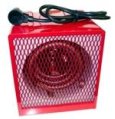|
Electric Garage Heaters - Portable, Permanent, Convection or Radiant?Electric garage heaters come in many different types and sizes. There is no one "best" type. All of them have their own pros and cons, and each type is better than another one in certain situations. There are lots of different options to choose from, and the type that will be the best for you depends on your particular needs and preferences. You may even decide to use a combination of two or three different types! The first distinction I am going to make is between portable electric space heaters and ones that are mounted in a fixed location. The advantages of a portable unit are obvious; you can move the heater to the area you are working in, or even take it with you to be used in another area of the house. Some small electric heaters are very inexpensive, so you can have several of them that can be used to heat different areas of the garage at the same time.
With electric garage heaters, "watts are watts"! For example, you can have 3 small 1500 watt heaters that you plug in to a regular wall socket. With all three of them running, you will be using 4500 watts of power, and putting out 5118 BTUs of heat with each, for a total of 15,354 BTUs. These 3 small electric heaters will put out the same amount of heat, and use the same amount of electricity, as one larger 4500 watt unit that is permanently mounted to the wall and requires a 220 volt circuit.
Besides the "portable or permanent" distinction, the two main classifications of electric garage heaters are convection type and radiant type. Simply stated, convection heat warms the air, and radiant heat warms objects. Convection heat works by air being drawn across a heated element. The element heats the air, and the heated air is then distributed throughout the room. Many convection type units use a fan to circulate the air, but a fan is not a requirement. There are several different designs of electric heaters that use convection. Some electric shop heaters have a series of electric coils only, while others have electric coils and a fan. These are usually the least expensive option, with prices starting at about $20. I have several of these that I use in my shop. A ceramic space heater uses electric coils attached to a ceramic core. The elements heat up the ceramic core very quickly. They don't get as hot as the coil-only units, so they are less likely to cause fires or burns. Oil filled electric heaters usually don't have fans. They rely on the natural air currents that are created when air is warmed up. Oil filled electric heaters take a while to get warm, but once they do, they will cycle on and off and continue to heat your garage while using very little electricity. I also have one of these that I use when I will be in my garage for a few hours. Electric panel heaters are usually mounted on a wall, and most rely on natural air currents to distribute the heat. As they heat up, they silently warm the air between the panel and the wall. The warm air will then rise, and cool air is drawn up from the floor to be heated. Radiant heat uses infrared light to warm objects in its path, just like the sun. Electric infrared heaters can be wall mounted or portable. They generally won't heat an entire area, as they don't warm the air and the heat does not circulate or get distributed throughout the garage. They work best for spot heating of a small, targeted area. One advantage of infrared electric garage heaters is that they don't stir up dust like convection type units with a fan. They are also useful if the garage door is opened frequently, where warm air from a convection heater would be lost out the door. The main disadvantages are the initial cost, and the fact that they only warm objects that are in their direct line of sight. Some electric heaters use a combination of convection and radiant heat methods, but most are either one or the other. There are lots of options to choose from
Return from Electric Garage Heaters to Garage Heating
|

Related Pages
on this site:
Garage Heating
Electric
Natural Gas
Propane - Convection
Propane - Radiant
Portable Propane
Ventless Propane
Radiant Tube
Wood Burning
Oil Filled
Waste Oil Furnaces
Waste Oil Heater Plans
Radiant Floor Heating System
Electric Radiant Floor Heat
Hydronic Radiant Floor Heat





 Larger, permanently mounted electric shop heaters have a few advantages, though. Many of them are built for industrial or commercial use, and will likely last longer than the inexpensive, small electric shop heaters. They are usually mounted near the ceiling, where they are out of the way and you don't have electrical cords that can be tripped over. There isn't any danger of them getting tipped over.
Larger, permanently mounted electric shop heaters have a few advantages, though. Many of them are built for industrial or commercial use, and will likely last longer than the inexpensive, small electric shop heaters. They are usually mounted near the ceiling, where they are out of the way and you don't have electrical cords that can be tripped over. There isn't any danger of them getting tipped over.